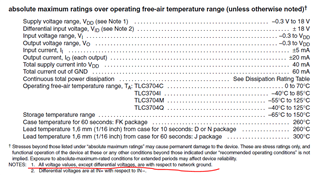Other Parts Discussed in Thread: LM311, LM6511, LM2903
Hi,
Can TLC3704IPWR be used in dual power supply configuration of +/- 3.3V or +/-5.0V
As VOL = is mentioned as 400mV max and also application circuits or test circuit voltage is considered as VDD = 5V.
Also there is note mentioned under absolute maximum ratings table that
"1. All voltage values, except differential voltages, are with respect to network ground." as shown below.
If this part can be used for dual power supply of +/- 3.3V or +/-5.0V (where total acceptable voltage is still less than 18V. Please let me know the VOL in that case.

Thanks & Regards,
Sunney

